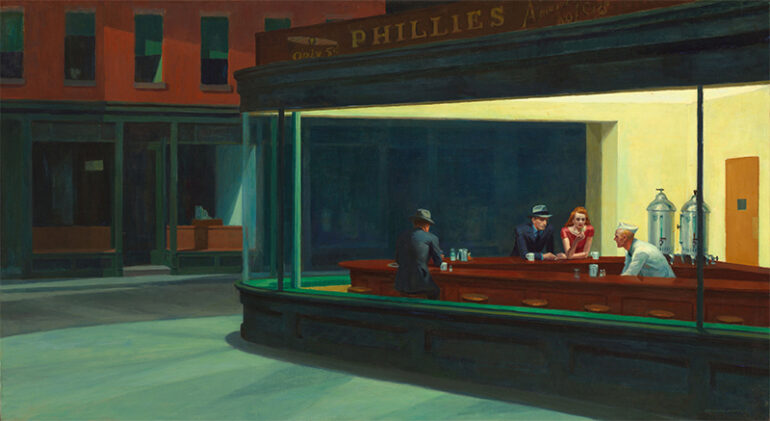The modern urban loneliness and disaffiliation of Edward Hopper‘s masterpiece Nighthawks, the moment standing still in a time-lapse of a cinematic cityscape.” With very great attention to detail and masterful use of light and shadow, Hopper invites his audience to meditate on the complications of modern life and the profound sense of loneliness it can generate. The iconic scene of the late-night diner is still resonating across generations, haunting in its stillness, with interconnected yet isolated figures, engendering discussion on the condition of urban alienation and human connection in modern society.
Edward Hopper: The Artist Behind Nighthawks
Edward Hopper’s masterly painting, Nighthawks, silently stands as an instance of urban isolation and alienation. The amount of detail is great, and the play of light and shadow from the artist highly implores one to become quiet amidst the noisy city. Through isolating a moment in time, frozen in the imaginary eye of the observer and framed by solitary figures and a stark setting, Hopper invites the viewer to reflect upon modern life with its accompanying deep sense of isolation.
The Iconic Scene: Analyzing Nighthawks
In Nighthawks, Edward Hopper creates a classic scene: the diner is open very late; there is great stillness in the chill of the air. The iconic composition—with angular lines and stark contrasts—captures a sense of unease and introspection. The figures become lost in the thought of one figure and become isolated, even though connected to shared solitude. The empty streets outside put the theme as very urban alienation, hence reflecting human experience from quite a populous skyline in a very deep manner.
Urban Isolation in Nighthawks
Edward Hopper’s Nighthawks is a sensuous description of several disinterested people within the superheated mise-en-scène of a busy setting in a major city; the single figures, though, are so close to each other, but lost in their worlds, they do little to represent anything but loneliness and disconnection. The empty streets and the stubborn electric light contribute to the in-your-face reality, showing the alienation characterizing the isolating facts of city life. Nighthawks becomes a touching reminder of human experience within an urban landscape.
Legacy of Nighthawks: Impact on Art and Culture
Edward Hopper’s Nighthawks was an influence on many works of artists and is a grand inspiration for a whole generation of artists—a cult figure for urban alienation and human connection. These legacies live on, in the sense that today’s contemporary artists still find artistic angles from which they look at conditions of isolation and loneliness within modern society. The iconic imagery of the Nighthawks does not stay within its initial context; it comes to symbolize the paradoxes of urban life, echoing in the viewers through time and across cultures.
Edward Hopper’s masterpiece “Nighthawks” has become one of the most emblematic symbols of the world’s urban loneliness and alienation, capturing modern life through its poignant portrayal of isolated individuals in a teeming city. Through the details and the use of light and shadow, Hopper brings alive the complexities of human existence and a sense of loneliness that plagues it. The far-reaching legacy of the Nighthawks still touches audiences as a strong mirror of the universal experience of urban isolation.
Photo Attribution:
1st & featured image https://upload.wikimedia.org/wikipedia/commons/a/a8/Nighthawks_by_Edward_Hopper_1942.jpg
2nd image by https://www.pexels.com/photo/food-man-people-woman-6856807/

